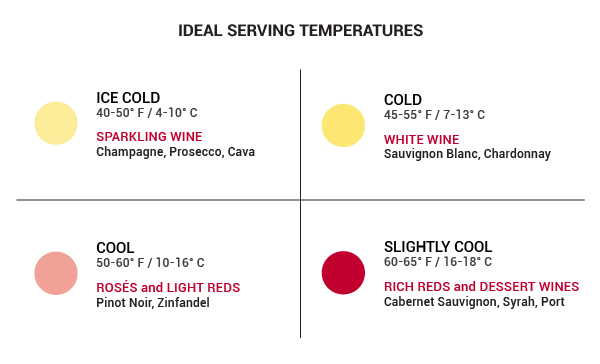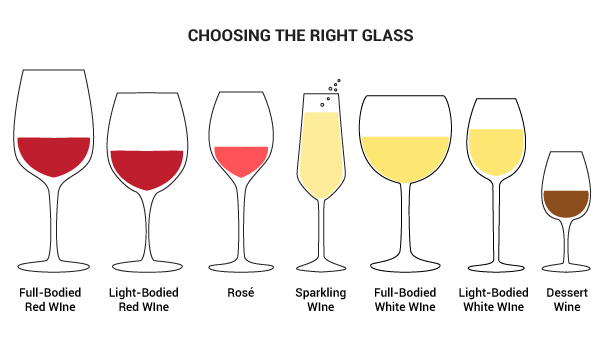An easy guide to serving, tasting and enjoying wine
Enjoying Wine
Once you understand the different types of wine and some characteristics like aromas, flavors and body, it’s time to serve, taste and enjoy some! Here are the best how-tos:
Serving Wine
Serving at the Right Temperature
Serving wine at the right temperature is crucial to fully enjoying all of flavors and aromas the wine has to offer.
Sparkling Wine
Sparkling wines should be served ice cold. A good choice would be to chill in the freezer an hour before serving.
Whites
White wines should be chilled in the refrigerator so that they are thoroughly cold when serving. Rule of thumb: the lighter the wine, the colder it should be before drinking.
Light-Bodied Reds
These reds should be cool but not refrigerated. Reds with more fruit flavors can be a little warmer to bring those flavors forward.
Other Reds and Dessert Wines
Full-bodied reds like Cabernet and dessert wines like Port should be slightly cooler than room temperature, but never served cold.


Opening the Bottle
- Cut the foil over the cork from the top and peel it away.
- Place the corkscrew slightly off center on the cork—this prevents the cork from tearing.
- Turn the corkscrew several times but never to the hilt of the corkscrew. This will keep the cork from breaking.
- Carefully twist the cork out.
Decanting
Decanting, or pouring the wine into another vessel, helps the wine aerate (increasing the amount of oxygen the wine is exposed to). This will greatly improve the flavor of reds, since the oxygen will help soften the wine’s tannins. Decant a wine about 45 minutes before serving.
Use the Right Glasses
There are three parts to a wine glass: the bowl, the stem and the foot.
Using the right wine glasses will greatly enhance your wine drinking experience. That’s because the shape and the size of the glass holds in the aroma vapors, and smelling the wine while drinking adds to the overall flavor.
The key is not to overfill — that is, don’t pour to the top. Most bottles will accommodate five glasses of wine at about five ounces each.
Red Wine Glasses
Larger bowls will help lessen the effect of tannins and make red wine taste smoother. Larger glasses will also help ethanol evaporate and increase the wine’s true flavor.
White Wine Glasses
Smaller glasses, with smaller bowls, help carry the floral aroma of light-body wines; larger bowls will help you taste the creamy texture of full-body whites (such as Chardonnay).


Whichever glass you use for wine, hold the base of the stem, not the bowl. Holding the bowl will warm the wine — something you want to avoid.
How to Wine Taste
Drinking wine seems straightforward, but using a little technique will greatly enhance your tasting experience. Try these steps to get the most out of your next glass:
Look
Hold the wineglass by the stem and look at the wine’s color. A white wine should be light and clear, while a red wine should be translucent with a rich color.
Swirl
Lightly swirl the glass by the stem, which will let oxygen in while releasing the wine's aromas. Examine the "legs," or the tracks on the inside of the glass. Those wine with high alcohol will have more pronounced legs.
Inhale
Place the rim of the glass under your nose and inhale long and deep through your nostrils to breathe in the aromas. Younger wines have stronger aromas, while older wines will neb more subdued and complex.
Sip
Take a sip to fill your mouth one-third full and swish the wine around to reach all parts of your palate. Pay attention to how the wine feels, how the taste changes as you swallow, and how long the flavor lingers.
Enjoy!